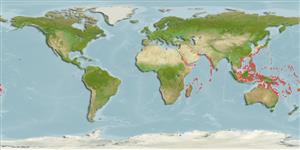Fusigobius longispinus Goren, 1978
Orange-spotted sand-goby
Ajouter votre observation dans Fish Watcher
| Native range | All suitable habitat | Point map | Year 2050 |

|
| This map was computer-generated and has not yet been reviewed. |
| Fusigobius longispinus AquaMaps Data sources: GBIF OBIS |
Envoyez vos Photos et vidéos
Pictures | Videos | Images GoogleFusigobius longispinus
Picture by Brokovich, E.
Pictures | Videos | Images GoogleFusigobius longispinus
Picture by Brokovich, E.
Classification / Names Noms communs | Synonymes | Catalog of Fishes(Genre, Espèce) | ITIS | CoL | WoRMS | Cloffa
> Gobiiformes (Gobies) > Gobiidae (Gobies) > Gobiinae
Etymology: Fusigobius: Latin, fusus = spindle + Latin, gobius = gudgeon (Ref. 45335).
Etymology: Fusigobius: Latin, fusus = spindle + Latin, gobius = gudgeon (Ref. 45335).
Environment: milieu / climate zone / depth range / distribution range Écologie
marin récifal; profondeur 9 - 25 m (Ref. 48637). Tropical
Distribution Pays | Zones FAO | Écosystèmes | Occurrences | Point map | Introductions | Faunafri
Indo-West Pacific: Red Sea and East Africa to the Marshall Islands, north to the Ryukyu Islands (Ref. 559), south to the Great Barrier Reef.
Taille / Poids / Âge
Description synthétique Clés d'identification | Morphologie | Morphométrie
Épines dorsales (Total) : 7; Rayons mous dorsaux (Total) : 9; Épines anales: 1; Rayons mous anaux: 7 - 8. Covered with evenly-spaced round orange spots; develops an elongate first dorsal spine with growth (Ref. 1602). Body whitish; about 4 patches on lateral side of body, triangular patch on caudal base; all fins whitish with orange spots on dorsal and caudal, Transverse scales 7. Predorsal scales 4. Head triangular in cross-section; snout short and pointed. Dorsal fin triangular in shape; in males, 1st dorsal spine elongated and extending over base of last dorsal ray when depressed; 2nd dorsal fin ray pointed posteriorly. Anal fin similar to 2nd dorsal. Pectoral fin large, extending beyond origin of anal fin. Pelvic fin cup-like with connecting membrane (Ref. 43541).
Life cycle and mating behavior Maturité | Reproduction | Frai | Œufs | Fécondité | Larves
Référence principale
Upload your references | Références | Coordinateur | Collaborateurs
Randall, J.E., 1995. Fusigobius Whitley, a junior synonym of the gobiid fish genus Coryphopterus gill. Bull. Mar. Sci. 56(3):795-798. (Ref. 10930)
Statut dans la liste rouge de l'IUCN (Ref. 130435: Version 2024-2)
Préoccupation mineure (LC) ; Date assessed: 26 June 2018
CITES
Not Evaluated
Menace pour l'homme
Harmless
Utilisations par l'homme
Pêcheries: sans intérêt; Aquarium: Commercial
FAO - Publication: search | FishSource |
Plus d'informations
Trophic ecology
Éléments du régime alimentaire
Composition du régime alimentaire
Consommation alimentaire
Food rations
Prédateurs
Éléments du régime alimentaire
Composition du régime alimentaire
Consommation alimentaire
Food rations
Prédateurs
Ecology
Écologie
Écologie
Population dynamics
Paramètres de croissance
Max. ages / sizes
Length-weight rel.
Length-length rel.
Fréquences de longueurs
Mass conversion
Recrutement
Abondance
Paramètres de croissance
Max. ages / sizes
Length-weight rel.
Length-length rel.
Fréquences de longueurs
Mass conversion
Recrutement
Abondance
Life cycle
Reproduction
Maturité
Maturity/Gills rel.
Fécondité
Frai
Spawning aggregations
Œufs
Développement de l'œuf
Larves
Dynamique des populations larvaires
Reproduction
Maturité
Maturity/Gills rel.
Fécondité
Frai
Spawning aggregations
Œufs
Développement de l'œuf
Larves
Dynamique des populations larvaires
Anatomy
Surface branchiale
Brain
Otolith
Surface branchiale
Brain
Otolith
Physiology
Body composition
Nutrients
Consommation d'oxygène
Type de nage
Vitesse de nage
Visual pigments
Fish sound
Diseases & Parasites
Toxicity (LC50s)
Body composition
Nutrients
Consommation d'oxygène
Type de nage
Vitesse de nage
Visual pigments
Fish sound
Diseases & Parasites
Toxicity (LC50s)
Genetics
Génétique
Heterozygosity
Héritabilité
Génétique
Heterozygosity
Héritabilité
Human related
Aquaculture systems
Profils d'aquaculture
Souches
Ciguatera cases
Stamps, coins, misc.
Aquaculture systems
Profils d'aquaculture
Souches
Ciguatera cases
Stamps, coins, misc.
Outils
E-book | Guide de terrain | Générateur de fréquences de longueur | Outil de dynamique de population | Carte par point | Classification Tree
| Catch-MSY |
Articles particuliers
Télécharger en XML
Sources Internet
AFORO (otoliths) | Aquatic Commons | BHL | Cloffa | BOLDSystems | Websites from users | FishWatcher | CISTI | Catalog of Fishes: Genre, Espèce | DiscoverLife | ECOTOX | FAO - Publication: search | Faunafri | Fishipedia | Fishtrace | GenBank: génôme, nucléotide | GloBI | Google Books | Google Scholar | Google | IGFA World Record | MitoFish | Bases de données nationales | Otolith Atlas of Taiwan Fishes | PubMed | Reef Life Survey | Socotra Atlas | Arbre de Vie | Wikipedia: aller à, chercher | World Records Freshwater Fishing | Zoobank | Zoological Record
Estimates based on models
Preferred temperature (Ref. 123201): 24.6 - 29.3, mean 28.1 °C (based on 2108 cells).
Phylogenetic diversity index (Ref. 82804): PD50 = 0.5005 [Uniqueness, from 0.5 = low to 2.0 = high].
Bayesian length-weight: a=0.01023 (0.00477 - 0.02194), b=3.01 (2.83 - 3.19), in cm total length, based on LWR estimates for this (Sub)family-body shape (Ref. 93245).
Niveau trophique (Ref. 69278): 3.3 ±0.3 se; based on size and trophs of closest relatives
Résilience (Ref. 120179): Haut, temps minimum de doublement de population inférieur à 15 mois (Preliminary K or Fecundity.).
Fishing Vulnerability (Ref. 59153): Low vulnerability (10 of 100).




